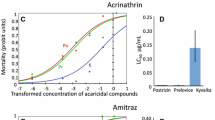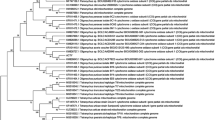Abstract
Two colonies of the carmine spider mite,Tetranychus cinnabarinus (Boisd.), were raised on beans in the laboratory. One originated from roses in a greenhouse which had received acaricidal treatments, and the other fromViola odorata L. in a garden where no pesticides had been used. Laboratory evaluation indicated that the greenhouse strain was highly resistant to dicofol (Kelthane) and bromopro-pylate (Neoron), moderately resistant to propargite (Omite), and slightly resistant to cyhexatin (Plictran); in the garden strain, there was no resistance to any of these acaricides.
On a strain of carmine spider mites which was identified and defined as resistant, several acaricides were evaluated in the laboratory for their contact toxicity to the mite by the slide dip method, and for their contact plus stomach toxicity by exposing the mites to sprayed leaves. Some of these acaricides were later tested in the field on two undetermined populations. Cyhexatin, triazophos (Hostathion), fentrifanil (PP-199) and R-28627 killed more than 90% of the mites by both methods and were effective in the field. NC-13292 was an ovicide only. Proclonol (R-8284) had a good effect in the slide dip method but was not so effective in the leaf exposure test. The compounds tested were phytotoxic to rose foliage only, but triazophos burned all the crops tested.
Similar content being viewed by others
References
Abbott, W.S. (1925) A method of comparing the effectiveness of an insecticide.J. econ. Ent. 18: 265–267.
Anon. (1974) Recommended methods for the detection and measurement of resistance of agricultural pests to pesticides. 10 tentative methods for spider mites and their eggs.Tetranychus spp.andPanonychus ulmi Koch.Pl. Prot. Bull. F.A.O. 22: 103–107.
Ascher, K.R.S. and Cwilich, R. (1960) Laboratory evaluation of acaricides againstTetrany-chus telarius L. on sugar beet and on beans.Israel J. agric. Res. 10: 159–163.
Ascher, K.R.S. and Cwilich, R. (1962) Field demonstrations on the control of red spider mites on cotton.Israel J. agric. Res. 12: 107–120.
Avidov, Z. and Harpaz, I. (1969) Plant Pests in Israel. Israel Universities Press, Jerusalem.
Brosh, S. (1972) [Tests for the control of the red spider mite in roses].Hassadeh 52: 1510–1511. (in Hebrew)
Cwilich, R. and Ascher, K.R.S. (1961) Organo-phosphor resistance of red spider mites on sugar beets.Israel J. agric. Res. 11: 135–136.
Dittrich, V. (1962) A comparative study of toxicological test methods on a population of the two-spotted spider mite.J. econ. Ent. 55: 644–648.
Dittrich, V. (1975) Acaricide resistance in mites.Z. angew. Ent. 78: 28–45.
Helle, W. and Van de Vrie, M. (1974) Problems with spider mites.Outlook Agric. 8: 119–125.
Hoskins, W.M. (1960) Use of the dosage-mortality curve in quantitative estimation of insecticide resistance.Misc. Publ. ent. Soc. Am. 2: 85–91.
Lippold, P. (1963) Acaricidal testing technique in the two-spotted spider mite.Adv. Acarol. 1: 174–180.
Overmeer, W.P.J., Vanzon, A. and Helle, W. (1975) The stability of acaricide resistance in spider mite (Tetranychus urticae) populations from rose houses.Entomologia expl. appl. 18: 68–74.
Plaut, H.N. and Cohen, M. (1967) The two-spotted (carmine) spider mite (Tetranychus cinnabarinus Boisd.) on apple in Israel.Z. angew. Ent. 60: 460–466.
Reynolds, H.T. (1962) Standardized laboratory detection methods for resistance determination in agricultural arthropod pests.Bull. ent. Soc. Am. 8: 9–14.
Smith, R.F. (1970) Pesticides: their use and limitations in pest management,in: Rabb, R.L. and Guthrie, F.E. [Eds]. Concepts of Pest Management, pp. 103–113. North Carolina State Univ., Raleigh, NC.
Tahori, A.S. and Raccah, B. (1970) Resistance to acaricides in the carmine spider mite in Israel.J econ. Ent. 63: 545–548.
Author information
Authors and Affiliations
Rights and permissions
About this article
Cite this article
Mansour, F.A., Plaut, H.N. The effectiveness of various acaricides against resistant and susceptible carmine spider mites. Phytoparasitica 7, 185–193 (1979). https://doi.org/10.1007/BF02981125
Received:
Issue Date:
DOI: https://doi.org/10.1007/BF02981125




